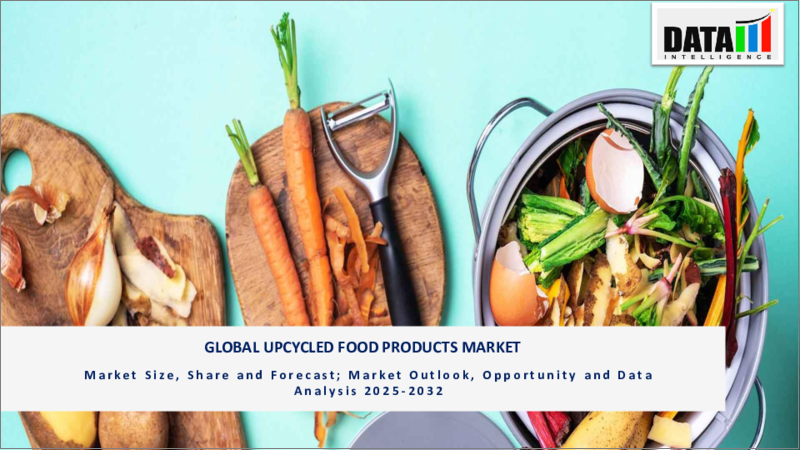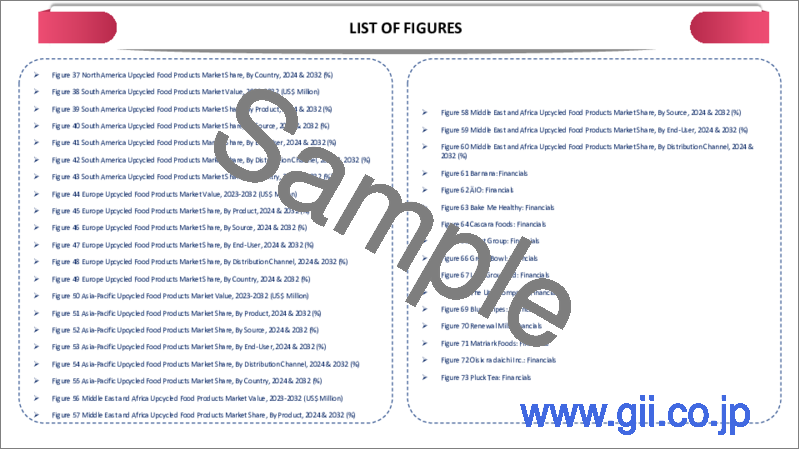|
|
市場調査レポート
商品コード
1629852
アップサイクル食品の世界市場(2024年~2031年)Global Upcycled Food Products Market - 2024-2031 |
||||||
カスタマイズ可能
適宜更新あり
|
|||||||
| アップサイクル食品の世界市場(2024年~2031年) |
|
出版日: 2024年12月30日
発行: DataM Intelligence
ページ情報: 英文 195 Pages
納期: 即日から翌営業日
|
- 全表示
- 概要
- 目次
世界のアップサイクル食品市場は2023年に592億米ドルに達し、2031年には960億米ドルに達すると予測され、予測期間2024年~2031年のCAGRは6.23%で成長する見込みです。
アップサイクル食品は、食品副産物や不要な農産物など、通常であれば廃棄される食材から作られます。このアプローチは、食品廃棄物の最小化、気候変動への対応、循環型経済の推進という増加傾向に沿ったものです。消費者が食品の選択が環境に与える影響をますます意識するようになるにつれ、アップサイクル製品は、健康上の利点と二酸化炭素排出量の削減の両方を提供する、革新的で環境に優しい代替品とみなされています。
持続可能性に加えて、アップサイクル食品はその栄養価の高さから人気を集めています。果物や野菜の皮から作られたスナック菓子や、使用済み穀物から作られた小麦粉など、アップサイクル原料から作られた製品の多くは、食物繊維、ビタミン、ミネラルを豊富に含んでいます。こうした特性は、栄養価の高い選択肢を求める健康志向の消費者にアピールします。この分野における技術革新が進化を続けるにつれて、アップサイクル食品が世界の食糧システムの主食となり、より持続可能で健康的な未来に貢献することが期待されます。
ダイナミクス
持続可能なソリューションにおけるアップサイクル食品の役割の拡大
UNEPによる「Global Waste Management Outlook 2024」で強調されているように、世界の廃棄物危機の高まりは、持続可能な解決策に対する緊急の必要性を促しています。廃棄物の量は、2023年の21億トンから2050年には38億トンに増加すると予測されており、廃棄物管理の経済的負担は急増します。2020年、廃棄物管理にかかる直接的なコストは2,520億米ドルでしたが、汚染、健康への影響、気候変動による隠れたコストを考慮すると、3,610億米ドルに急増しました。
大きな介入がなければ、2050年には6,403億米ドルに達する可能性があり、こうしたコストと環境破壊を抑制するための緊急行動が必要であることは明らかです。この差し迫った問題が、食品余剰物、製品別、廃棄物を価値ある製品に変えるアップサイクル食品市場の急成長に拍車をかけています。廃棄物を利用可能な製品に変換することで、この市場は廃棄物削減の必要性と、持続可能な代替品への需要の高まりの両方に対応しています。
アップサイクルされた食材は、循環型経済モデルにシームレスに適合し、廃棄物管理コストを大幅に削減すると同時に、新たな経済機会を生み出す可能性があります。消費者と産業界が持続可能性をますます優先するようになるにつれて、アップサイクル食品市場は、環境への影響を最小限に抑え、より持続可能で資源効率の高い食品システムを育成する上で極めて重要な役割を果たす態勢を整えています。
食品技術の進歩
食品技術の進歩は、食品廃棄物を高品質の食用製品に変えることを容易にすることによって、アップサイクル食品市場の成長を促進しています。新たなアップサイクル手法によって、従来であれば廃棄されていた食材の品質、安全性、魅力が向上しています。これによって、アップサイクル食品は、持続可能性や廃棄物の削減に関心のある消費者にとってより魅力的なものとなり、ユニークで環境に優しい製品を生み出す一助となっています。
例えば、2023年11月にグドゥルンが発売した「カカオフルーツ・バイツ」は、チョコレート用のカカオ豆を収穫した後、通常は捨てられてしまうカカオの実を、新たなチョコレート製品に利用しました。カカオの実をアップサイクルすることで、廃棄物を減らすと同時に、美味しくて持続可能なお菓子を提供することができ、環境に優しい製品への需要と一致します。
同様に、2024年2月、ワーナーズディスティラリーは、不要な果物や皮などの余剰食品を原料にしたアルコール飲料シリーズ「トラッシュ・アンド・トレジャー・スピリッツ」を発売しました。通常なら無駄になるこれらの食材が、高品質のスピリッツに生まれ変わるこのイノベーションは、食品技術がいかに廃棄物を創造的に高級製品に再利用できるかを示しており、消費者にユニークで持続可能な選択肢を提供すると同時に、食品廃棄物の削減に貢献しています。
高い生産コスト
確立されたサプライチェーンとプロセスに依存する従来の食品生産とは異なり、アップサイクルには、加工施設、保管、包装といった特殊なインフラへの多額の投資が必要となります。こうした追加投資は、特に小規模の事業者にとってはコストがかさみ、収益性を達成することがより困難になります。特に小規模の事業者は、大規模生産の恩恵がなければ、こうしたコストを吸収するのに苦労する可能性があります。
さらに、アップサイクル食品の市場はまだ成長段階にあるため、業界は規模の経済による恩恵をまだ十分に享受していません。大規模生産ができなければ、アップサイクル食品はしばしば高い単価に直面することになり、従来の食品と比較して価格競争力が低下する可能性があります。このような価格格差は、価格に敏感な消費者がアップサイクル製品を選ぶことを躊躇させる可能性があります。
目次
第1章 調査手法と調査範囲
第2章 定義と概要
第3章 エグゼクティブサマリー
第4章 市場力学
- 影響要因
- 促進要因
- 持続可能なソリューションにおけるアップサイクル食品の役割の拡大
- 食品技術の進歩
- 抑制要因
- 生産コストの上昇
- 機会
- 影響分析
- 促進要因
第5章 産業分析
- ポーターのファイブフォース分析
- サプライチェーン分析
- 価格分析
- 規制分析
- DMIの見解
第6章 供給源別
- 食品廃棄物
- 農業副産物
- 醸造所および蒸留所の廃棄物
- その他
第7章 成分タイプ別
- タンパク質
- 繊維
- 油脂
- 小麦粉
- 甘味料
- その他
第8章 製品別
- スナックと飲み物
- ベーカリーと菓子類
- 原材料と添加物
- 肉・シーフード
- ペットフード
- その他
第9章 流通チャネル別
- スーパーマーケット/ハイパーマーケット
- 専門店
- オンライン
- その他
第10章 地域別
- 北米
- 米国
- カナダ
- メキシコ
- 欧州
- ドイツ
- 英国
- フランス
- イタリア
- スペイン
- その他欧州
- 南米
- ブラジル
- アルゼンチン
- その他南米
- アジア太平洋
- 中国
- インド
- 日本
- オーストラリア
- その他アジア太平洋
- 中東・アフリカ
第11章 競合情勢
- 競合シナリオ
- 市況・シェア分析
- M&A分析
第12章 企業プロファイル
- AIO
- 会社概要
- ネイチャーポートフォリオと説明
- 財務概要
- 主な発展
- Bake Me Healthy
- Barnana
- cascarafoods
- Green Bowl Foods
- CRUST Group
- I Am Grounded
- Matriark Foods
- Oisix Ra Daichi Co., Ltd.
- Pluck Tea
第13章 付録
Global Upcycled Food Products Market reached US$ 59.2 billion in 2023 and is expected to reach US$96 billion by 2031, growing with a CAGR of 6.23 % during the forecast period 2024-2031.
Upcycled foods are made from ingredients that would otherwise be discarded, such as food by-products, and unwanted produce. This approach aligns with the growing trend of minimizing food waste, addressing climate change, and promoting a circular economy. As consumers become increasingly aware of the environmental impact of their food choices, upcycled products are seen as an innovative and eco-friendly alternative, offering both health benefits and a reduced carbon footprint.
In addition to sustainability, upcycled foods are gaining popularity due to their nutritional value. Many products made from upcycled ingredients, such as snacks made from fruit or vegetable peels or flour from spent grains, are rich in fiber, vitamins, and minerals. These attributes appeal to health-conscious consumers seeking nutritious options. As innovation in this space continues to evolve, upcycled foods are expected to become a staple in the global food system, contributing to a more sustainable and healthier future.
Dynamics
Growing Role of Upcycled Food Products in Sustainable Solutions
The growing global waste crisis, highlighted in the Global Waste Management Outlook 2024 by UNEP, is driving the urgent need for sustainable solutions. With the amount of waste projected to rise from 2.1 billion tonnes in 2023 to 3.8 billion tonnes by 2050, the economic burden of waste management is set to skyrocket. In 2020, the direct cost of managing waste was USD 252 billion, but when considering the hidden costs from pollution, health impacts, and climate change, it surged to USD 361 billion.
Without significant intervention, this could reach USD 640.3 billion by 2050, making it clear that urgent action is required to curb these costs and environmental damages. This pressing issue has fueled the rapid growth of the upcycled food products market, which turns food surplus, by-products, or waste into valuable products. By converting waste into usable products, this market addresses both the need for waste reduction and the growing demand for sustainable alternatives.
Upcycled ingredients fit seamlessly into the circular economy model, which could significantly reduce waste management costs while also creating new economic opportunities. As consumers and industries increasingly prioritize sustainability, the upcycled food market is poised to play a crucial role in minimizing environmental impact and fostering a more sustainable, resource-efficient food system.
Advances in Food Technology
Advances in food technology are driving the growth of the upcycled food products market by making it easier to turn food waste into high-quality, edible products. New upcycling methods are improving the quality, safety, and appeal of ingredients that would otherwise be discarded. This makes upcycled food more attractive to consumers who are interested in sustainability and reducing waste, helping to create unique and environmentally friendly products.
For instance, the Cacaofruit Bites were launched by Gudrun in November 2023. The cacao fruit, which is usually thrown away after the cacao beans are harvested for chocolate, is now being used to create a new chocolate product. This upcycling of the cacao fruit helps reduce waste while offering a delicious and sustainable treat, aligning with the demand for eco-friendly products.
Similarly, in February 2024, Warner's Distillery launched Trash and Treasure Spirits, a range of alcoholic drinks made from surplus food, including unwanted fruits and peels. These ingredients, which would normally go to waste, are being transformed into high-quality spirits. This innovation shows how food technology can creatively repurpose waste into premium products, helping to reduce food waste while offering unique, sustainable options for consumers.
Higher Production Costs
Unlike traditional food production, which relies on well-established supply chains and processes, upcycling requires significant investments in specialized infrastructure such as processing facilities, storage, and packaging. These additional investments can be costly for businesses, particularly smaller ones, making it more challenging to achieve profitability. Smaller-scale operations, in particular, may struggle to absorb these costs without the benefit of large-scale production.
Furthermore, as the market for upcycled foods is still in its growth phase, the industry has not yet realized the full benefits of economies of scale. Without the ability to produce at a larger scale, upcycled food products often face higher unit costs, which can make them less price-competitive compared to conventional food products. This price disparity can discourage price-sensitive consumers from opting for upcycled options, especially when cheaper, traditional alternatives are readily available.
Segment Analysis
The global upcycled food products market is segmented based on source, ingredient type, product, distribution channel, application, and region.
Solution to The Global Food Waste Crisis
The global upcycled food products market is segmented based on source into food waste, agricultural by-products, and brewery and distillery Waste. Food waste is the dominant source driving the global upcycled food products market, accounting for a significant portion of municipal solid waste. As MSW is projected to rise from 2.1 billion tonnes in 2023 to 3.8 billion tonnes by 2050, according to the United Nations Environment Programme, food waste remains a major issue, with much of it still edible but discarded.
Upcycled food products help tackle this problem by repurposing food scraps, surplus ingredients, and imperfect produce into new, valuable items, promoting sustainability. The dominance of food waste is clear as it is the primary source of upcycled products. While other by-products like agricultural residues and brewery waste contribute, food waste remains the largest and most impactful segment. As demand for eco-friendly, sustainable food options grows, upcycled food products will continue to expand.
Geographical Penetration
Demand For Sustainability in North America
North America dominates the market with growing consumer demand for sustainability, strong innovation in food technology, and supportive infrastructure. Increasing consumer awareness of food waste's environmental impact has driven demand for sustainable and upcycled food products, which help reduce waste while offering nutritious alternatives. Additionally, North American companies are leading the way in innovation, developing a wide range of upcycled ingredients from food by-products.
Government support further enhances the market expansion. The US government's commitment to addressing food waste is seen with the June 2024 unveiling of the National Strategy for Reducing Food Loss and Waste. This initiative, central to President Biden's climate agenda, aims to reduce food waste by 50% by 2030, addressing the critical role food waste plays in methane emissions while promoting a circular economy.
By supporting this effort, US is positioning itself as a global leader in sustainable food systems and organic waste recycling, providing a boost to the growing $46 billion upcycled ingredients market, which is used for the development of upcycled food products. This government-backed strategy further strengthens North America's leadership in sustainable food practices, creating a more favorable environment for the continued growth of upcycled food products.
Competitive Landscape
The major global players in the market include AIO, Bake Me Healthy, Barnana, cascarafoods, Green Bowl Foods, CRUST Group, I Am Grounded, Matriark Foods, Oisix Ra Daichi Co., Ltd., and Pluck Tea.
Sustainability Analysis
The upcycled food products market is experiencing significant growth driven by an increasing consumer demand for sustainable and eco-friendly alternatives. By repurposing unwanted ingredients that would otherwise go to waste, upcycled food products help reduce food waste, a major global environmental issue. This approach not only minimizes environmental impact but also promotes a circular economy by turning food by-products into valuable, marketable items.
As consumers become more aware of sustainability, they are increasingly willing to support brands that contribute to reducing waste and lowering their carbon footprints. This market also presents significant opportunities for innovation and business growth. Companies in the upcycled food space are developing creative ways to transform food waste into high-quality, nutritious products, expanding the variety of upcycled goods available.
By Source
- Food Waste
- Agricultural by Products
- Brewery and Distillery Waste
- Other
By Ingredient Type
- Proteins
- Fibers
- Oils and Fats
- Flours
- Sweeteners
- Others
By Product
- Snacks & Beverages
- Bakery & Confectionery
- Ingredients & Additives
- Meat & Seafood
- Pet Food
- Other
By Distribution Channel
- Supermarkets & Hypermarkets
- Specialty Stores
- Online
- Other
By Region
- North America
- US
- Canada
- Mexico
- Europe
- Germany
- UK
- France
- Italy
- Rest of Europe
- South America
- Brazil
- Argentina
- Rest of South America
- Asia-Pacific
- China
- India
- Japan
- Australia
- Rest of Asia-Pacific
- Middle East and Africa
Key Developments
- In November 2023, Gudrun launched Cacaofruit Bites, created through upcycling to reduce waste by turning side streams into valuable ingredients.
- In August 2024, Upcycled Foods, Inc. unveiled Atoria's Family Bakery Mini Upcycled Naan, a collaboration with the Upcycled Foods Lab. These mini flatbreads are made from upcycled barley, wheat, and rye flour.
- In February 2024, Warner's Distillery launched Trash and Treasure Spirits, a range of spirits made from surplus food and ingredients, including unwanted fruits and peels that would otherwise go to waste.
Why Purchase the Report?
- To visualize the global upcycled food products market segmentation based on source, ingredient type, product, distribution channel, application, and region, as well as understand key commercial assets and players.
- Identify commercial opportunities by analyzing trends and co-development.
- Excel data sheet with numerous upcycled food products market-level data points with all segments.
- PDF report consists of a comprehensive analysis after exhaustive qualitative interviews and an in-depth study.
- Product mapping available as excel consisting of key products of all the major players.
The global upcycled food products market report would provide approximately 70 tables, 70 figures and 195 pages.
Target Audience 2024
- Manufacturers/ Buyers
- Industry Investors/Investment Bankers
- Research Professionals
- Emerging Companies
Table of Contents
1. Methodology and Scope
- 1.1. Research Methodology
- 1.2. Research Objective and Scope of the Report
2. Definition and Overview
3. Executive Summary
- 3.1. Snippet by Source
- 3.2. Snippet by Ingredient Type
- 3.3. Snippet by Product
- 3.4. Snippet by Distribution Channel
- 3.5. Snippet by Region
4. Dynamics
- 4.1. Impacting Factors
- 4.1.1. Drivers
- 4.1.1.1. Growing Role of Upcycled Food Products in Sustainable Solutions
- 4.1.1.2. Advances in Food Technology
- 4.1.2. Restraints
- 4.1.2.1. Higher Production Costs
- 4.1.3. Opportunity
- 4.1.4. Impact Analysis
- 4.1.1. Drivers
5. Industry Analysis
- 5.1. Porter's Five Force Analysis
- 5.2. Supply Chain Analysis
- 5.3. Pricing Analysis
- 5.4. Regulatory Analysis
- 5.5. DMI Opinion
6. By Source
- 6.1. Introduction
- 6.1.1. Market Size Analysis and Y-o-Y Growth Analysis (%), By Source
- 6.1.2. Market Attractiveness Index, By Source
- 6.2. Food Waste
- 6.2.1. Introduction
- 6.2.2. Market Size Analysis and Y-o-Y Growth Analysis (%)
- 6.3. Agricultural by Products
- 6.4. Brewery and Distillery Waste
- 6.5. Other
7. By Ingredient Type
- 7.1. Introduction
- 7.1.1. Market Size Analysis and Y-o-Y Growth Analysis (%), By Ingredient Type
- 7.1.2. Market Attractiveness Index, By Ingredient Type
- 7.2. Proteins
- 7.2.1. Introduction
- 7.2.2. Market Size Analysis and Y-o-Y Growth Analysis (%)
- 7.3. Fibers
- 7.4. Oils and Fats
- 7.5. Flours
- 7.6. Sweeteners
- 7.7. Others
8. By Product
- 8.1. Introduction
- 8.1.1. Market Size Analysis and Y-o-Y Growth Analysis (%), By Product
- 8.1.2. Market Attractiveness Index, By Product
- 8.2. Snacks & Beverages
- 8.2.1. Introduction
- 8.2.2. Market Size Analysis and Y-o-Y Growth Analysis (%)
- 8.3. Bakery & Confectionery
- 8.4. Ingredients & Additives
- 8.5. Meat & Seafood
- 8.6. Pet Food
- 8.7. Other
9. By Distribution Channel
- 9.1. Introduction
- 9.2. Market Size Analysis and Y-o-Y Growth Analysis (%), By Distribution Channel
- 9.3. Market Attractiveness Index, By Distribution Channel
- 9.4. Supermarkets/Hypermarkets
- 9.4.1. Introduction
- 9.4.2. Market Size Analysis and Y-o-Y Growth Analysis (%)
- 9.5. Specialty Stores
- 9.6. Online
- 9.7. Other
10. By Region
- 10.1. Introduction
- 10.1.1. Market Size Analysis and Y-o-Y Growth Analysis (%), By Region
- 10.1.2. Market Attractiveness Index, By Region
- 10.2. North America
- 10.2.1. Introduction
- 10.2.2. Key Region-Specific Dynamics
- 10.2.3. Market Size Analysis and Y-o-Y Growth Analysis (%), By Source
- 10.2.4. Market Size Analysis and Y-o-Y Growth Analysis (%), By Ingredient Type
- 10.2.5. Market Size Analysis and Y-o-Y Growth Analysis (%), By Product
- 10.2.6. Market Size Analysis and Y-o-Y Growth Analysis (%), By Distribution Channel
- 10.2.7. Market Size Analysis and Y-o-Y Growth Analysis (%), By Country
- 10.2.7.1. US
- 10.2.7.2. Canada
- 10.2.7.3. Mexico
- 10.3. Europe
- 10.3.1. Introduction
- 10.3.2. Key Region-Specific Dynamics
- 10.3.3. Market Size Analysis and Y-o-Y Growth Analysis (%), By Source
- 10.3.4. Market Size Analysis and Y-o-Y Growth Analysis (%), By Ingredient Type
- 10.3.5. Market Size Analysis and Y-o-Y Growth Analysis (%), By Product
- 10.3.6. Market Size Analysis and Y-o-Y Growth Analysis (%), By Distribution Channel
- 10.3.7. Market Size Analysis and Y-o-Y Growth Analysis (%), By Country
- 10.3.7.1. Germany
- 10.3.7.2. U.K.
- 10.3.7.3. France
- 10.3.7.4. Italy
- 10.3.7.5. Spain
- 10.3.7.6. Rest of Europe
- 10.4. South America
- 10.4.1. Introduction
- 10.4.2. Key Region-Specific Dynamics
- 10.4.3. Market Size Analysis and Y-o-Y Growth Analysis (%), By Source
- 10.4.4. Market Size Analysis and Y-o-Y Growth Analysis (%), By Ingredient Type
- 10.4.5. Market Size Analysis and Y-o-Y Growth Analysis (%), By Product
- 10.4.6. Market Size Analysis and Y-o-Y Growth Analysis (%), By Distribution Channel
- 10.4.7. Market Size Analysis and Y-o-Y Growth Analysis (%), By Country
- 10.4.7.1. Brazil
- 10.4.7.2. Argentina
- 10.4.7.3. Rest of South America
- 10.5. Asia-Pacific
- 10.5.1. Introduction
- 10.5.2. Key Region-Specific Dynamics
- 10.5.3. Market Size Analysis and Y-o-Y Growth Analysis (%), By Source
- 10.5.4. Market Size Analysis and Y-o-Y Growth Analysis (%), By Ingredient Type
- 10.5.5. Market Size Analysis and Y-o-Y Growth Analysis (%), By Product
- 10.5.6. Market Size Analysis and Y-o-Y Growth Analysis (%), By Distribution Channel
- 10.5.7. Market Size Analysis and Y-o-Y Growth Analysis (%), By Country
- 10.5.7.1. China
- 10.5.7.2. India
- 10.5.7.3. Japan
- 10.5.7.4. Australia
- 10.5.7.5. Rest of Asia-Pacific
- 10.6. Middle East and Africa
- 10.6.1. Introduction
- 10.6.2. Key Region-Specific Dynamics
- 10.6.3. Market Size Analysis and Y-o-Y Growth Analysis (%), By Source
- 10.6.4. Market Size Analysis and Y-o-Y Growth Analysis (%), By Ingredient Type
- 10.6.5. Market Size Analysis and Y-o-Y Growth Analysis (%), By Product
- 10.6.6. Market Size Analysis and Y-o-Y Growth Analysis (%), By Distribution Channel
11. Competitive Landscape
- 11.1. Competitive Scenario
- 11.2. Market Positioning/Share Analysis
- 11.3. Mergers and Acquisitions Analysis
12. Company Profiles
- 12.1. AIO
- 12.1.1. Company Overview
- 12.1.2. Nature Portfolio and Description
- 12.1.3. Financial Overview
- 12.1.4. Key Developments
- 12.2. Bake Me Healthy
- 12.3. Barnana
- 12.4. cascarafoods
- 12.5. Green Bowl Foods
- 12.6. CRUST Group
- 12.7. I Am Grounded
- 12.8. Matriark Foods
- 12.9. Oisix Ra Daichi Co., Ltd.
- 12.10. Pluck Tea
LIST NOT EXHAUSTIVE
13. Appendix
- 13.1. About Us and Services
- 13.2. Contact Us






